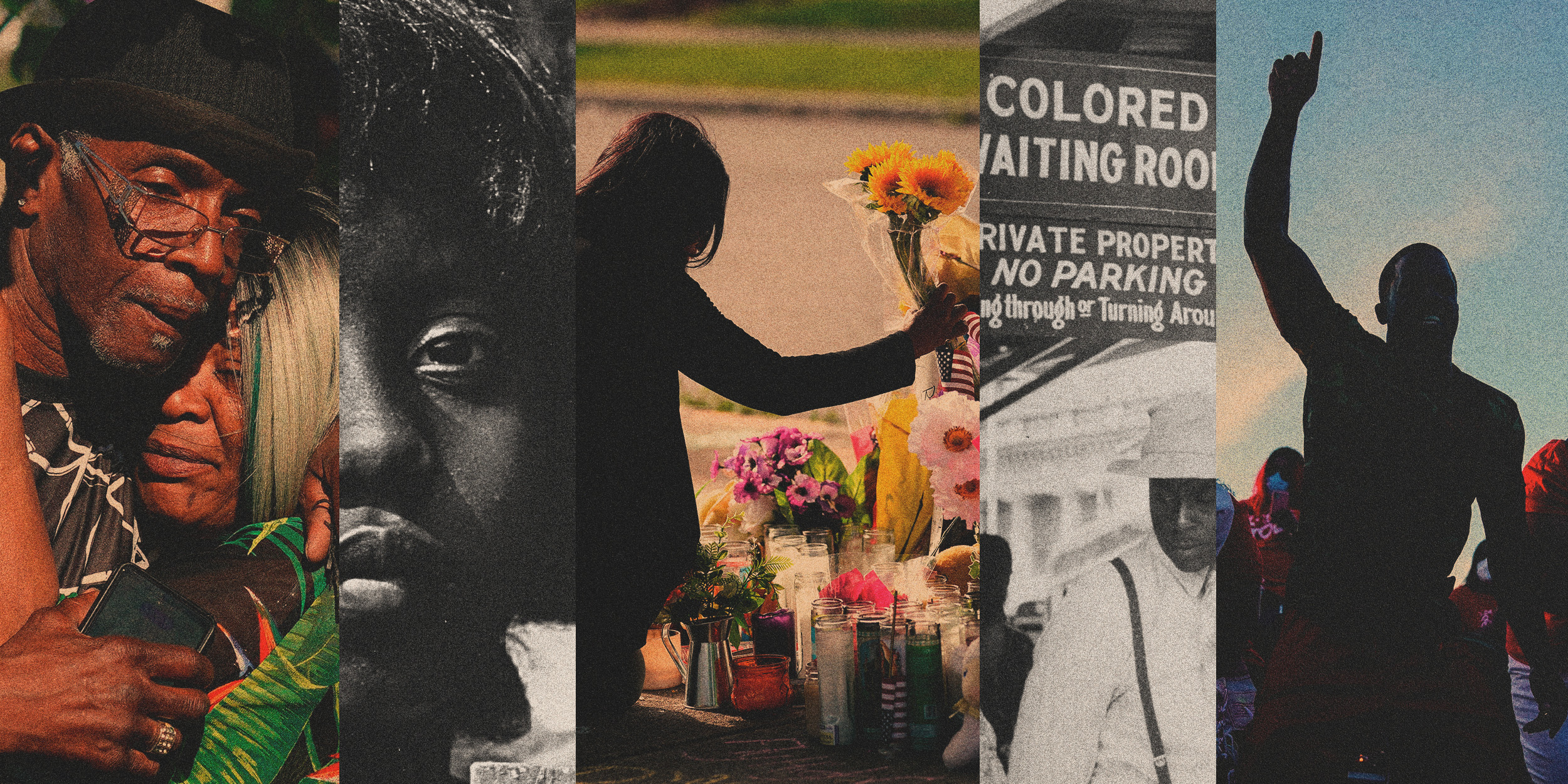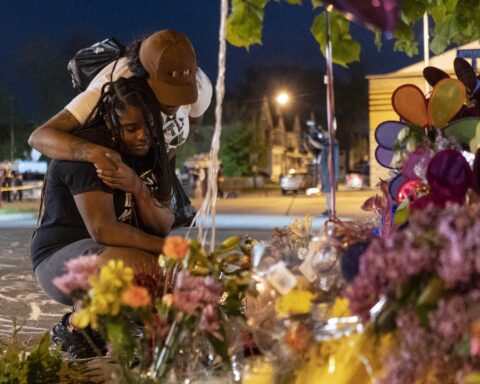Some 2,000 Black people were killed from 1865 to 1876, during the Reconstruction era, the result of a widespread effort to use white supremacist terror to maintain economic, political and social control over newly emancipated Black people, according to the Equal Justice Initiative. This reign of terror worked to stamp out any semblance of Black progress after slavery, working hand in hand with oppressive Jim Crow laws that enforced legal segregation throughout the country for decades.
A white man is accused of continuing this legacy of white supremacist terror on Saturday when he allegedly traveled to a supermarket in a Black neighborhood in Buffalo, New York, and killed 10 people, most of them Black.
Experts say his act was not episodic or unprecedented, but is part of America’s violent history of using racial terror to intimidate and exert power over Black people. In the days since the shooting, conversations about hate crimes and gun control have consumed the nation. But experts say the Buffalo shooting must be viewed within the context of both historical racist backlash to Black existence and the white supremacist violence that has increasingly become normalized in the country today. The Buffalo shooting, experts say, is not a dangerous turning point for the country, but a continuation of the broad violence Black people in the U.S. have experienced for centuries.
“This is the product of America’s culture of violence, its deeply entrenched racism,” said Bernard Powers, director of the Center for the Study of Slavery in Charleston and the College of Charleston’s academic liaison for the Universities Studying Slavery consortium. The shooting “cannot be separated from it. It’s the product of the unwillingness of most white Americans to deal with and address white supremacy and white supremacist tendencies in their own communities.”
Authorities say the suspect, Payton Gendron, 18, traveled more than three hours from his home in Conklin, New York, to the Tops Friendly Market in Buffalo, dressed in tactical gear, and shot 13 people, 11 of whom were Black, killing 10 and wounding three. He livestreamed the attack and was arrested at the scene. Gendron was arraigned hours after the shooting in Buffalo City Court on one count of first-degree murder, the Erie County District Attorney’s Office said.
Gendron laid out specific plans to attack Black people at the market in a 180-page document in which he identified himself as a white supremacist, racist, and fascist, authorities said. He wrote that he specifically targeted the area due, in part, to its high Black population.
A 2021 report from the University at Buffalo found that the health, housing, income and education conditions for Black people in Buffalo had not improved, and in some cases, had declined in the last 30 years. And experts like Henry Louis Taylor, a professor of urban and regional planning at the University at Buffalo, have said the poor conditions for Black people in the city, and its standing as one of the most segregated areas of the country, makes it a prime target for acts of violence.
In his reported diatribe, Gendron repeatedly cited the white supremacist “great replacement” theory, the false idea that nonwhite people are attempting to replace white Americans through interracial marriage, immigration and violence. Authorities said he also lamented what he described as Black communities’ reliance on government resources and social programs.
Gendron’s allegedly wrote that he was radicalized on 4chan due to boredom during the early months of the pandemic in 2020. But this theory is not native to 4Chan — Manisha Sinha, an American and African American history professor at the University of Connecticut, said its origins stretch back even further, to slavery and the Reconstruction era. Although fear of Black autonomy and power in the country has long existed, “great replacement” began to take shape as a definitive theory in the late 19th century.
“This is an idea that was organized at the height of Jim Crow and scientific racism,” Sinha said. “You have a situation where people in the post-war South just cannot accept the idea of people of African descent as equal citizens and fellow citizens in the republic. This kind of racist opposition to Black rights and Black citizenship is one of the long, lingering legacies and afterlife of slavery in this country. So you have this huge campaign of racist terror.”
Stories of this terror stretch throughout America’s history. Among the thousands of Black people killed during the Reconstruction era were six Black men slain by a white mob in Duplin County, North Carolina, in 1865, for demanding that a white landowner pay them for their work as sharecroppers. In the decades to come, lynch mobs enforced social codes, spoken and unspoken, to enforce the oppression of Black Americans.
A century ago, the nation witnessed what is considered one of the worst incidents of racial violence in its history. On May 31, 1921, more than 2,000 white people in Oklahoma descended upon Tulsa’s Greenwood District, known as “Black Wall Street,” where Black business leaders, homeowners and civic leaders thrived. An estimated 300 people died in what is now known as the Tulsa Race Massacre, and the mob, and Tulsa police, burned more than 1,200 homes, businesses and churches along with a school, public library and hospital. History shows a consistent pattern of Black advancement being met with white supremacist violence. As the 20th century went on, racists would bomb Black churches, terrorize civil rights activists, lynch and otherwise murder countless Black people, and assassinate one of America’s most influential Black leaders, Martin Luther King Jr.
The Buffalo shooting comes two years after the nation saw what appeared to be the start of a racial reckoning. The 2020 deaths of George Floyd and Breonna Taylor prompted calls to “defund the police” — a movement that has faced fierce opposition — and combat the structural racism that has shaped the conditions of Black communities for centuries.
That year, the FBI reported a surge in hate crimes against Black people and, last summer, the agency published complete 2020 statistics and found that the number of incidents had reached its highest level in 12 years.
Meanwhile, Republican lawmakers and leaders have passed laws limiting voting rights, banning educators from teaching race history in schools, restricting abortion and banning books about race and gender. Experts have said that the increase in hate crimes and discriminatory legislation indicates a rising tide in anti-Black sentiments, but that is nothing new for the country.
“We classify these crimes today as hate crimes … but in many respects, the word hate can be a bit misleading because this is actually about power,” said William Horne, a historian and co-founder of The Activist History Review. He added that it is important to see the Buffalo shooter’s violence not as a “lone wolf” endeavor, but as a symptom of a larger problem in the nation.
“This problem is not incidental, it’s not episodic, the problem is systemic. That requires a systemic, thorough, dramatic response,” Horne said. “That is a response we haven’t seen from the Biden administration, from the Department of Justice, from state and local officials, and that promotes an atmosphere of permissiveness. It promotes exactly these kinds of acts.”
K Agbebiyi, an abolitionist organizer who co-created the Defund the Police #8toAbolition campaign in 2020, added that the Buffalo shooting cannot be divorced from historical context, from the nation’s history of racism.
“This racism won’t be fixed solely through talking to your family members, or posting stuff online,” Agbebiyi said. “It will require people to join organizations or movements that are working to restructure society.”
Gendron cited other mass shootings in his reported document, and made known his support for Brenton Tarrant, the shooter in the 2019 mosque attack in Christchurch, New Zealand; Patrick Crusius, accused of killing 23 people, most of whom were Latino, in an El Paso, Texas, Walmart; Dylann Roof, who killed nine people at a Black church in Charleston, South Carolina, in 2015, and others.
Powers, who lives in Charleston, said he is not surprised that Gendron looked up to Roof because “there are a lot of folks out there who were not as deranged as Dylann Roof, but still shared his sentiments.” Still, he said he has marveled at the collaboration among anti-racist organizations, and the allyship he’s seen in Charleston in the years since the tragedy. This, he said, makes him hopeful that out of Saturday’s shooting in Buffalo will come unity.
“Don’t be discouraged by this. Take comfort in what we’ve seen in the BLM demonstrations,” Powers said, encouraging the city’s Black population. “Look toward your allies, because they’re there. And people who have never been involved in supporting Black causes will do so now.”




